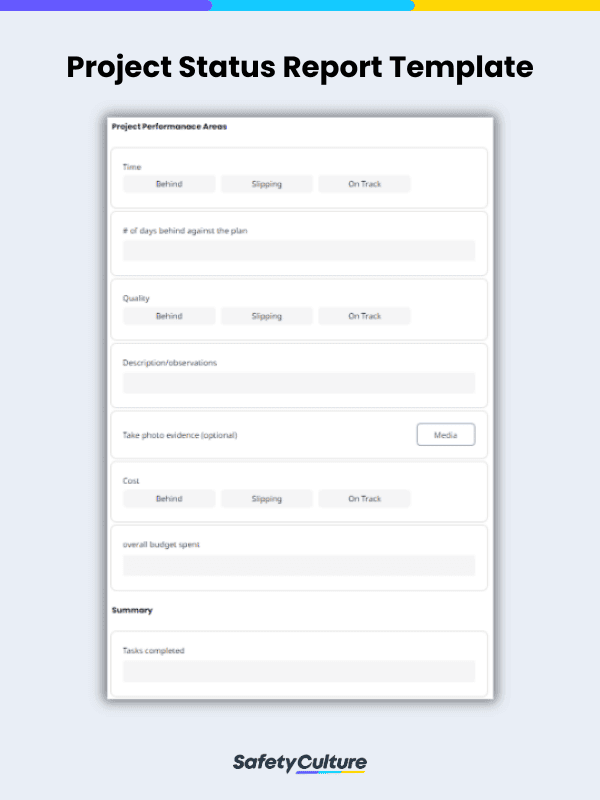Project Status Report Template
A project status report template is a tool used in tracking and recording the progress of an ongoing business project or plan. Project status reports are completed by project managers evaluating key areas such as time, quality, and budget. These reports fundamentally show a summary of the tasks accomplished, to-dos, and the current status of the project.
5 Benefits of Using Project Status Report Template
The purpose of project status reports is to ensure objectives and deliverables are being met and key stakeholders are kept informed. These reports can be done daily, weekly, or monthly throughout the life cycle of a business plan. Here are the top 5 benefits of using project status reports in your organization:
- Develops a good communication system within teams;
- Keeps stakeholders informed and updated about the progress of the project;
- Streamlines reporting processes;
- Enables actions to be taken on risks and potential hazards identified; and
- Improves support systems needed to achieve goals
Understanding the RAG Status Rating System
The RAG status is an essential part of completing a project status or progress report. RAG stands for red, amber, and green. Each color indicates the current status of a key performance area, which typically covers quality, timing, budget, and scope.
- RED – this color indicates that the project has identified significant issues and roadblocks which can not be handled by the project manager alone. These issues need to be escalated to project sponsors or project board for corrective actions to be implemented immediately.
- AMBER – this color means that there are still problems being encountered but can be actioned by the project manager and the delivery team. With this, the project board still needs to be updated and notified regarding the matter.
- GREEN – this color shows that the project is now running smoothly and that all aspects are within tolerance.
6 Essential Information That A Project Status Report Template Must Have
Reporting on the status of a project essentially requires getting all the data out to the key persons and stakeholders. Project managers should know the most vital information that they need to present how a project is being monitored and managed properly. Here are the six essential information that a project status report must have:
General Information of the Project
The fundamental information of every report. This should include the title or name of the project, people involved in the project, timelines, location, and project owners.
Project Metrics
Metrics must be established during the planning stage. It’s vital to include numbers to project status reports to substantiate the statements. This is important to assess if the project is meeting its goals with these key focus and in the end if it’s a success. In addition, these metrics are a way to identify what needs immediate attention.
Issues, Risks, and Problems
Take note of all the issues detected over the course of the project to date. Describe their nature, their severity, impact on the project, and recommended actions or solutions.
Milestone Review
The milestones serve as episodes to where the story lies currently. Thus, these are major phases of a project that helps break up the project into more digestible parts. They are also not considered as tasks but a series of them that would lead project owners to the next checkpoints. In this section, it is important to list what milestones were accomplished over time.
Status of the Project
By using the RAG rating system mentioned above, project owners can visually provide an overall status of the project.
Project Summary
Include a brief summary of the progress made on the current status of the project. Include the completion date and costs of the project. Explain the issues found, their impact on the overall project lifecycle, expenses needed if necessary, and recommended solutions to mitigate these risks and the expected outcome once the problems are resolved.
Best Practices
Creating project status reports can be a routine task for project managers throughout a single project life cycle. Being knowledgeable of the best practice when reporting progress is essential to ensure that all significant information is communicated clearly and documented effectively as the historical records of a completed project can make future planning easier and more comprehensive. Here are some best practices when creating a project status report:
- Project status reports are a vital tool for improving communication across teams. Use its maximum potential to deliver the most necessary data to key persons in real-time.
- Establishing the right KPIs or key areas to measure when working on a project helps project owners determine what they need to focus on reporting.
- Do not put any unnecessary information that would make the project status report vague and unobscured. It is always effective to simplify how data is reported.
- Conduct due diligence to ensure that the project status report does not contain unwanted and unsubstantiated information and that it provides what the target audience needs.
- Use a standard project status report template for consistency
- Utilize good project status reporting tools that can help project owners to streamline their reporting processes and eliminate the hassle of paper-based reporting.



